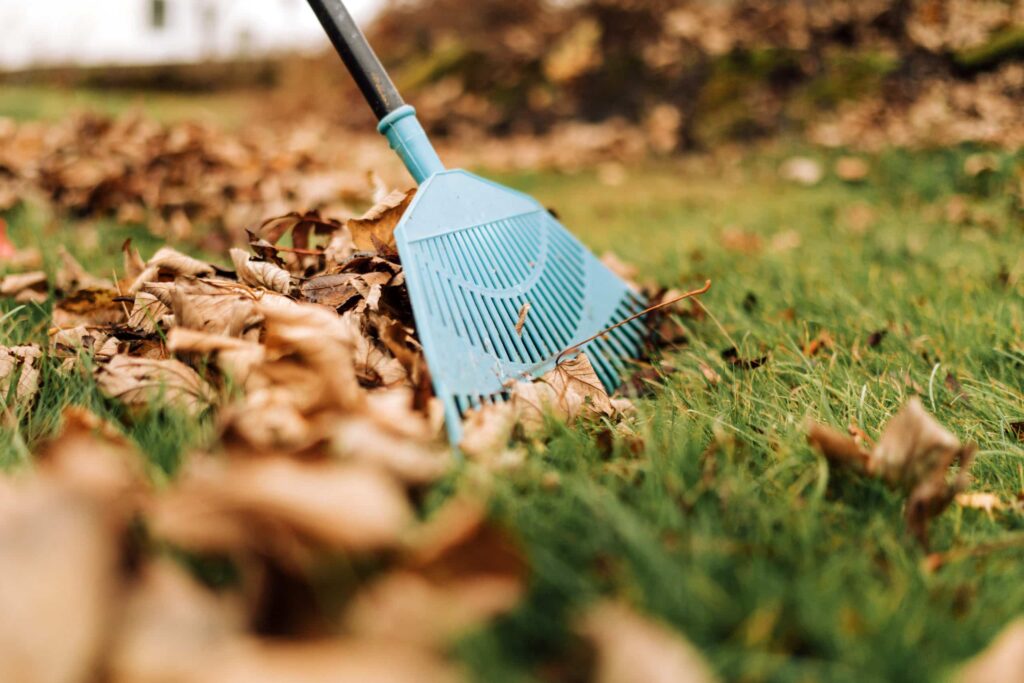
Tips for Raking Leaves
If you’re not a fan of mowing your lawn, raking may be even lower on your list of fun things to do. However, disturbing the rest of those beautifully colored leaves sleeping on your lawn is a necessity — and not just for the curb appeal! There are actually health benefits to removing the leaves from your yard. The lawn care experts at Fairway Lawns are here to break it down for you.
The Importance of Raking Leaves
If you aren’t diligent in raking your leaves in the fall, you might be in for a patchy lawn come spring. The fact is, fallen leaves create a barrier over the lawn. A mat of leaves blocks the sunlight that’s already pretty hard to come by in the fall/winter months. Most warm season grasses like Bermuda grass will dim and take on a tan color, but this is the season for cool season grasses like Fescue to grow, so sunlight is still essential.
With leaves covering the grass, your lawn becomes deprived of air and water while it traps moisture. As a result, your yard will be far more susceptible to becoming a breeding ground for insects, fungi, and diseases that can kill patches of even the healthiest grass.
Raking has the added benefit of removing thatch buildup and harmful weeds. After raking into piles, you can use them as mulch for all your landscaping needs, or you can also use the leaves for compost in your spring garden.
Best Leaf Raking Tips
Rake regularly - You may think that waiting until all your leaves have fallen from the trees is a more efficient way to handle your raking duties, but the longer leaves lay around and the thicker they accumulate, the greater the damage you cause to your grass. Regular raking is the best way to avoid lawn damage and ensure a healthy yard come spring.
Know what to wear - Raking can be a dusty task, so consider wearing a hat, long-sleeved shirt, and long pants before beginning. Don’t forget to wear heavy-duty gloves to prevent blisters from forming on your hands. If you have allergies, be sure to wear a mask while you rake.
Use the right rake - Rakes with narrow spreads gather fewer leaves and add unnecessary time to the chore. Make sure you choose a rake that has a wider tine spread (ideally about 30 inches). Additionally, rakes labeled “no-clog” have angled tines that won’t pierce the leaves and create blockages.
Use the wind to your advantage - Be sure to rake in the same direction that the gentle breeze is blowing, otherwise, every stroke will lift leaves and send them backward, requiring you to go over them again and again. Shorter rake strokes and small piles are most efficient on breezy days.
Don’t rake when the wind is too strong - A light breeze can help move the dry leaves; however, if it is too windy out you shouldn’t rake at all. Leaves from the neighbor's yard will likely cover your yard by the time you are finished, making all of your effort basically pointless.
Divide and conquer - If you rake all of the leaves into one giant pile in the center of your lawn, you’ll constantly be moving back and forth, wasting a lot of time and energy. Instead, separate your lawn into quadrants, then rake all the leaves in each quadrant in rows, working from one end to the other. By raking the leaves in a grid pattern, you’ll save time and end up with an easier cleanup.
Rake leaves onto tarps - Rather than bending over every few seconds to pick up leaves and place them in a bag or wheelbarrow, you can save time by raking the leaves onto a large tarp, then rolling the tarp into a cylinder and using it as a funnel to fill individual lawn bags.
Stomp on piles of leaves if you can’t finish - If you’ve already raked those lightweight leaves into a pile and get called away, they could be blown across the lawn by the time you get back. Stomping on the pile of leaves before you go compacts them and helps keep them from blowing around. When you return, you can pick up right where you left off and finish the job.
Rake before it rains - Rain makes fallen leaves become soggy and dense, making it way more difficult as they clump together and clog your rake. If raking is on your to-do list and the forecast predicts rain, get out on the lawn ASAP.
Rake gently - Unlike raking that is done to prepare a garden bed for planting, leaf raking requires only gentle motions. It is all about the surface, so the flexible tines on a leaf rake should not dig into the lawn or remove thatch. You don't even have to put any downward pressure on the rake head — simply lift the rake head up and out, and let it fall softly on the surface of the leaves, then pull it toward you. The bent shape of the tines is sufficient for grabbing and pulling the leaves.
Rake before winter - Make sure all of your leaves are off of the grass before snowfall or frost. Not only are leaves harder to rake up after winter, but your grass can die from being underneath the weight of leaves for months.
Professional Lawn Care Services
From your grass to your trees and shrubs, the professional lawn care experts at Fairway Lawns can help maintain your yard and keep it healthy and protected. Contact our knowledgeable team today to discuss how we can help take care of your lawn this fall!